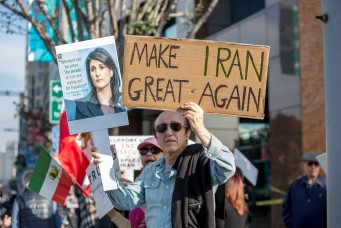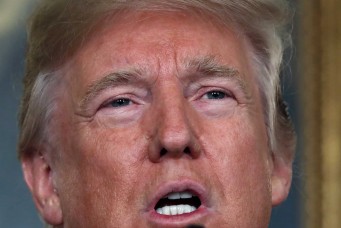Amid Fuel Protests, Iran’s Hardliners See Historic Opportunity
Citing external pressures and foreign intervention, Tehran has brutally cracked down on dissidents.

An Iraqi boy runs between burning tires during ongoing anti-government protests in Najaf, November 27. Alaa al-Marjani/Reuters
Iranian authorities sparked widespread protests after their abrupt decision to increase the price of gasoline on November 21. The government quickly clamped down with brute force and an unprecedented week-long internet shutdown.
While the full extent of the brutality is only now becoming clear, far more protesters appear to have been killed in the crackdown than in the 2017-2018 national protests and the Green Movement in 2009. The reaction to the protests is just the latest sign that the Islamic Republic is headed toward becoming more ironfisted at home and less conciliatory abroad—not toward the “behavior change” that the Trump administration purportedly seeks.
The gas price hike decision and subsequent protests occurred against a complex backdrop. Iran is currently bearing the brunt of a “maximum pressure” campaign by the Trump administration marked by severe economic sanctions and, according to journalist Barak Ravid, “efforts to encourage protests within Iran”. Iranian domestic politics are also undergoing a seismic shift in favor of hardline elements largely due to this outside pressure.
Trump officials and their allies have lost no time in pointing to the recent protests in Iran as evidence of the success of their maximum pressure campaign. The reality on the ground tells a different story, however. The Iranian regime is not on its last legs but is growing more insular and repressive. The net effect of maximum pressure has been to create the opposite of a conducive political environment in Iran for new negotiations with the United States, or a brighter, more free, and prosperous future for the Iranian people. The final result may well be entrenched U.S.-Iran hostilities for decades to come and an Iran more aggressive with its nuclear program and broader foreign policies.
“Maximum Pressure” Feeds Claims of Foreign Interference
The recent nationwide crackdown is among the most brutal in the Islamic Republic’s 40-year history. Footage posted on social media showed live ammunition being fired directly at protesters, riot police beating people, and many Iranians shot and/or killed. According to Amnesty International, at least 161 have been killed and hundreds more injured. The protests were also marked by the widespread destruction of public and private property, with BBC Persian reporting on November 20 that damage was done to 407 banks, 180 gas stations, 32 ambulances, 5 emergency health centers, and roughly $12 million in damages to shops.
The reason for the timing of the sharp gas price hike remains a mystery. The Iranian government was fully aware that any decision to reduce gasoline subsidies would flare up public grievances. Recent history is replete with such protests in a country where cheap gas is an integral part of the social contract between citizens and the state. Indeed, President Hassan Rouhani backed off a similar gas price hike in late 2017 amid protests then over deteriorating economic conditions and other deep-seated grievances shared by millions of Iranians.
However, unlike in 2017, the recent gas price hike was not included in a proposed national budget, which would have required it to go to parliament for approval. It was also not simultaneous with redistributing the revenue from the gas price hike to lower income households in the form of direct cash transfers, which is what happened under former President Mahmoud Ahmadinejad. Instead, it was spontaneously announced to immediate effect by Rouhani on a Friday morning, the Iranian weekend. The stage for the protests was thus bizarrely set by the Iranian government itself.
While Iranian leaders are quick to frame many protesters as “seditionists,” the paranoia of the Islamic Republic appears to have been further fueled by the regime-change rhetoric and actions of the Trump administration and its regional allies. This includes efforts documented in the Western press to push President Donald Trump’s Iran policy toward economic sabotage and fomenting unrest, which former National Security Advisor John Bolton also called for in an August 2017 memo. Recently, Brian Hook, the State Department’s Special Representative for Iran, said Washington was “very pleased with the protests” there, making clear that a goal of “maximum pressure” is to get Iranians to the streets.
There does not appear to be any credible evidence of a direct foreign role in the protests, despite the Iranian government’s claims to the contrary. However, judging by the lethality of the crackdown and its coupling with a severing of internet connections with the outside world, it appears that outside pressure moved the Iranian state’s apparatus for mass repression to hair trigger.
Domestic Political Feuds Over Gas Price Hike
In the meantime, rival factions in Tehran have traded fierce and contradictory accusations over the gas price hike. Rouhani has said he himself did not know when the price hike would go into effect until the day it was implemented. Supreme Leader Ayatollah Ali Khamenei dodged responsibility for the price increase by saying he was not “an expert” but that he supported the decision because it was made by “the High Council of Economic Coordination” made up of Rouhani, the parliamentary speaker, and judiciary chief. However, Judiciary Chief Ebrahim Raisi has said the price hike was a “suggestion” of the Rouhani administration.
When the price hike was announced, it was immediately attacked most vociferously by Rouhani’s conservative rivals. Telegram channels associated with the Islamic Revolutionary Guard Corps (IRGC) urged people to leave their cars in traffic as a form of protest, which later did happen. Ahmad Jannati, the powerful chair of the Assembly of Experts and secretary of the Guardian Council, rebuked Rouhani for not “preparing public opinion”. Meanwhile, former IRGC chief Mohammad Ali Jafari, accused Rouhani of “playing into the enemy’s hands”.
Mojtaba Zonnour, a hardline MP and chair of the parliament’s influential foreign policy and national security commission, compared Rouhani to Abolhassan Banisadr, the first president after the 1979 revolution who was later ousted and labelled a “traitor”. Zonnour then introduced an impeachment bill against Rouhani—based on allegations of “divisive rhetoric” and “not implementing the policy of a resistance economy”—which received over 60 signatures from parliamentarians.
Hardliners Consolidating Power Amid Maximum Pressure
The feud over the gas price hike and crackdown is only a small piece of a campaign from conservative and hardline forces in Iran seeking to sideline their reformist and moderate rivals, and to use the pretext of outside pressure and domestic instability to tighten security and their grip on power.
The Trump administration’s May 2018 abrogation of the Joint Comprehensive Plan of Action (JCPOA) on Iran’s nuclear program discredited the moderates and reformists inside the Iranian government who had staked their political capital on the accord and its expected economic benefits. Now, ahead of parliamentary elections in February 2020 and presidential elections the following year, emboldened hardline forces view the current impasse with the United States as a historic opportunity and are in no rush to negotiate.
The gas price hike occurred amid a broader consolidation of power by conservative and hardline forces under the guise of an anti-corruption drive. This campaign is being driven by Raisi, who unsuccessfully sought to unseat incumbent moderate Rouhani in the 2017 presidential election. However, the campaign goes beyond a mere crackdown on corruption or even the usual political competitions in Tehran. It instead has to do with Khamenei’s legacy and succession, cementing the political system, and consolidating power behind hardline figures.
The anti-corruption campaign and overall economic downturn provide the main context for the upcoming elections. In recent years, corruption in Iran reached a zenith both in its scope and the level of public discontent. A case in point is the May 2017 presidential election, when all four candidates accused each other, including Rouhani and Raisi, of corruption during live television debates. Six months later in the winter of 2017, protests rooted in economic grievances broke out in roughly 100 cities. The latest protests that swept the country are of a similar nature.
Raisi has been tasked with spearheading the anti-corruption drive, but his role goes beyond his position as judiciary chief. He is the special representative of the political system to execute a critical project, which, if successful, will usher in a new political dynamic in Iran and lay the groundwork for the era after Khamenei.
Parviz Fatah, who is close to Khamenei and the head of the Foundation of the Oppressed and Disabled, one of Iran’s largest economic enterprises, may have given an indication of the broad strategic aim of the anti-corruption campaign in recent statements.
“Don’t worry or be afraid of the arrests. The Islamic Republic is undergoing an internal change, and the release of some people from this train is natural and inevitable. It is possible that in some places the revolution will be wounded, but this is necessary for the healing and excellence of the revolution,” he said.
Since Khamenei approved the creation of special corruption courts in August 2018, the extent of the anti-corruption crackdown has been unprecedented in the Islamic Republic’s history. This is reflected in the number of people arrested, the severity of the sentences handed down, and the geographic spread of the arrests.
Based on judiciary statistics, as of October 2019, 978 sentences have been passed. Some 60 judges have been fired for corruption, and 116 people have been barred from getting government jobs. Additionally, nine people have been sentenced to death, 4 to life imprisonment, 44 to long prison sentences, with 10 exiled internally. Reports of new arrests and sentences come nearly every day.
The scope of the arrests has come from most centers of power and targeted members of all political factions. Those arrested include senior figures within the judiciary, executive branch managers, members of parliament, members of local and municipal governments, the children of former Revolutionary Guard and regular army commanders, the heads of major companies, and the head of powerful government foundations. Notably, Rouhani’s brother Hossein Fereydoun has also been sentenced to 5 years in prison for accepting bribes.
Raisi came into his post as Judiciary Chief in March with a mandate from Khamenei to “clean house.” However, he is not exercising any oversight over the financial activities of the IRGC, religious foundations, and institutions under Khamenei. He has also overseen a new wave of arrests of journalists and political activists even as he has made himself front and center over pardons granted to some arrested laborers and activists.
The powerful forces behind the anti-corruption campaign hope it will translate into support in the upcoming elections. Raisi’s approval rating is already up sharply in recent polls. The consequential aim of these forces is to decide the succession to the 80-year old Khamenei and thus the future of Iran for years to come. As such, they have no interest in supporting negotiations with the United States or in improving economic conditions at this juncture, as both would boost prospects for Rouhani and the moderate-reformist camp in the elections.
It is widely understood that the Trump administration’s “maximum pressure” campaign has taken the United States and Iran to the brink of war. It has spurred Iran to break the JCPOA’s nuclear limits and lash out more aggressively in the region. The consequences inside Iran may be even more significant in terms of laying the stage for perennial U.S.-Iran hostilities, with the most reactionary elements of the Iranian system greatly emboldened. The Trump administration cannot continue denying the flaws of the maximum pressure strategy if it is sincerely seeking a new deal with Iran or trying to avoid the quagmire of a catastrophic war.
Sina Toossi is a Senior Research Analyst at the National Iranian American Council (NIAC). He tweets @SinaToossi.
Read More



